Fluid and electrolyte imb - Study guides, Class notes & Summaries
Looking for the best study guides, study notes and summaries about Fluid and electrolyte imb? On this page you'll find 155 study documents about Fluid and electrolyte imb.
Page 4 out of 155 results
Sort by
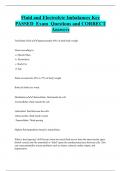
-
Fluid and Electrolyte Imbalances Key PASSED Exam Questions and CORRECT Answers
- Exam (elaborations) • 21 pages • 2024
-
- $8.49
- + learn more
Total Body Fluid Approximately 60% of total body weight Varies according to: a. Muscle Mass b. Electrolytes c. Body Fat d. Age Water accounts for 45% to 75% of body weight. Body fat holds less water. Distribution -Intracellular- fluid inside the cell -Extracellular- fluid outside the cel
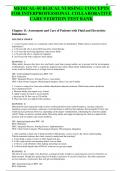
-
MEDICAL-SURGICAL NURSING: CONCEPTS FOR INTERPROFESSIONAL COLLABORATIVE CARE 9 EDITION TEST BANK Chapter 11: Assessment and Care of Patients with Fluid and Electrolyte Imbalances
- Exam (elaborations) • 8 pages • 2024
-
Available in package deal
-
- $9.99
- + learn more
MEDICAL-SURGICAL NURSING: CONCEPTS FOR INTERPROFESSIONAL COLLABORATIVE CARE 9 EDITION TEST BANK Chapter 11: Assessment and Care of Patients with Fluid and Electrolyte Imbalances
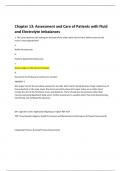
-
Chapter 13: Assessment and Care of Patients with Fluid and Electrolyte Imbalances
- Exam (elaborations) • 35 pages • 2024
-
- $12.99
- + learn more
1. The nurse observes skin tenting on the back of the older adult client's hand. Which action by the nurse is most appropriate? a. Notify the physician. b. Examine dependent body areas. c. Assess turgor on the client's forehead. d. Document the finding and continue to monitor. ANSWER: C Skin turgor cannot be accurately assessed on an older adult client's hands because of age-related loss of tissue elasticity in this area. Areas that more accurately show skin turgor status on an ol...
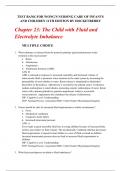
-
Chapter 23: The Child with Fluid and Electrolyte Imbalance Test Bank for Wong's Nursing Care of Infants And Children 11th Edition by Hockenberry
- Exam (elaborations) • 23 pages • 2023
-
Available in package deal
-
- $4.49
- + learn more
TEST BANK FOR WONG'S NURSING CARE OF INFANTS AND CHILDREN 11TH EDITION BY HOCKENBERRY Chapter 23: The Child with Fluid and Electrolyte Imbalance MULTIPLE CHOICE 1. What substance is released from the posterior pituitary gland and promotes water retention in the renal system? a. Renin b. Aldosterone c. Angiotensin d. Antidiuretic hormone (ADH) ANS: D ADH is released in response to increased osmolality and decreased volume of intravascular fluid; it promotes water retention in the ...

-
HESI RN Fluid and electrolyte imbalances Notes
- Exam (elaborations) • 15 pages • 2024
- Available in package deal
-
- $16.49
- + learn more
Always look at labs before giving any fluids FLUID About 60% of the adult body is made up of fluids Infants are at an increased risk for imbalances and are effected most by fluid shifts Total body H2O decreases from birth to old age Types of Fluid 1. Intracellular : fluid inside the cell. ( K+ is most abundant) 2/3 of all fluid in the body is intracellular. 2. Extra cellular: three types of extra cellular fluid A. Intravascular: capillary blood , 3L Plasma 3L Blood components ( RBC) B....
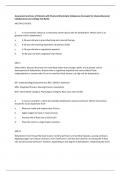
-
Assessment and Care of Patients with Fluid and Electrolyte Imbalances (Concepts for Interprofessional Collaborative Care College Test Bank)
- Exam (elaborations) • 15 pages • 2024
-
- $10.49
- + learn more
The Assessment and Care of Patients with Fluid and Electrolyte Imbalances is a valuable resource for healthcare professionals who want to improve their knowledge and skills in assessing and caring for patients with fluid and electrolyte imbalances. It provides practical information and guidance on how to provide high-quality care to patients with these conditions, promoting better health outcomes and quality of life.
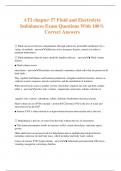
-
ATI chapter 57 Fluid and Electrolyte Imbalances Exam Questions With 100% Correct Answers
- Exam (elaborations) • 18 pages • 2024
- Available in package deal
-
- $12.49
- + learn more
ATI chapter 57 Fluid and Electrolyte Imbalances Exam Questions With 100% Correct Answers ◯ Fluid can move between compartments (through selectively permeable membranes) by a variety of methods - answer(diffusion, active transport, ltration, osmosis) in order to maintain homeostasis. ◯ Fluid imbalances that the nurse should be familiar with are: - answer■ Fluid volume deficits ■ Fluid volume excess electrolytes - answerElectrolytes are minerals (sometimes called salts) that are p...

-
fluid and electrolyte imbalances nephro unit Exam (elaborations) Questions & answers | latest update version 2024 | Verified 100% Correct Explations | Already Passed Graded A+| Actual Complete Solution - DISTINCTION GUARANTEED
- Exam (elaborations) • 6 pages • 2024
-
- $7.99
- + learn more
fluid and electrolyte imbalances nephro unit Exam (elaborations) Questions & answers | latest update version 2024 | Verified 100% Correct Explations | Already Passed Graded A+| Actual Complete Solution - DISTINCTION GUARANTEED
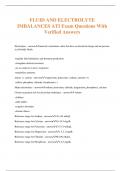
-
FLUID AND ELECTROLYTE IMBALANCES ATI Exam Questions With Verified Answers
- Exam (elaborations) • 14 pages • 2024
- Available in package deal
-
- $12.49
- + learn more
FLUID AND ELECTROLYTE IMBALANCES ATI Exam Questions With Verified Answers Electrolytes - answerminerals (sometimes salts) that have an electrical charge and are present in all bodily fluids. -regulate fluid imbalance and hormone production -strengthen skeletal structures -act as catalysts in nerve responses -metabolize nutrients anions vs. cations - answer-magnesium, potassium, sodium, calcium (+) -sulfate, phosphate, chloride, bicarbonate (-) Major electrolytes - answersodium, potass...
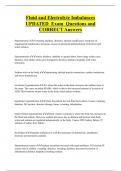
-
Fluid and Electrolyte Imbalances UPDATED Exam Questions and CORRECT Answers
- Exam (elaborations) • 14 pages • 2024
-
- $8.49
- + learn more
nappropriate antidiuretics hormone, excessive parenteral administration of dextrose and water solution Hypernatremia watery diarrhea, inability to quench thirst, burns large surface area, diuretics, heat stroke, status post therapeutic abortion, diabetes insipidus with water restriction Sodium roles in the body maintaining skeletal muscle contraction, cardiac conduction, and nerve transmission euvolemic hyponatremia is where the water in the body increases but sodium stays at the sa...

That summary you just bought made someone very happy. Also get paid weekly? Sell your study resources on Stuvia! Discover all about earning on Stuvia


